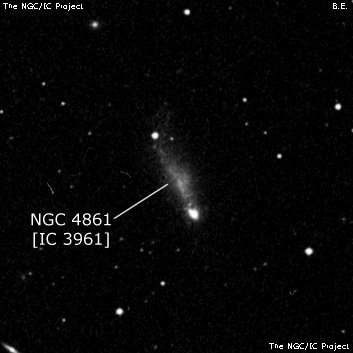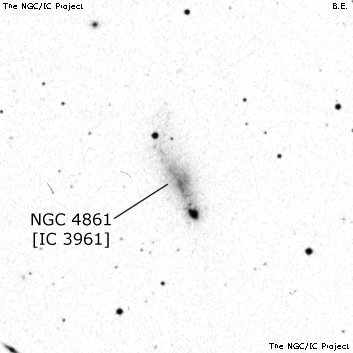NGC/IC Project Restoration Effort
(This is a very very beta version)
NGC4861


Basic Information
Location and Magnitude
Right Ascension: 12:59:1.8
Declination: +34:51:43
Constellation: CVN
Visual Magnitude: 13.5
Historic Information
Discoverer: Herschel W.
Year of discovery: 1785
Discovery aperture: 18.7
Observational
Summary description: vF, pL, vmE 30° ±, bet 2 st
Sub-type: SBm
Corwin's Notes
=====
NGC 4861 = IC 3961. Both of these numbers certainly apply to the galaxy
itself and not, as supposed by CGCG, the first to the bright HII region, and
the second to the galaxy. William Herschel's and Lord Rosse's (on three
nights) descriptions leave no doubt that they saw the galaxy clearly. Not
only are Wolf's position and description very accurate, he has also marked the
correct object on his plate (though one of the "stars" which he notes as
flanking it is actually the HII region). However, the NGC position (from Sir
William's observation) is a bit off, and this may have misled both Wolf and
Dreyer into believing that Wolf's object was new.
I had the pleasure of seeing the galaxy at the 1992 Texas Star Party through
Tom Polakis's superb 13", and it exactly matched the descriptions left by
the earlier observers. The HII region was quite stellar until I viewed it
with a nebular filter: it took on a bit of fuzz then, and the foreground
star at the other end of the galaxy faded quite a bit (the galaxy itself
faded not quite as much; it must have diffuse oxygen and hydrogen emission
spread through it). Modern visual observers do have some advantages over
Lord Rosse -- though none of us can yet beat him for sheer aperture!
Steve's Notes
=====
NGC 4861
48" (4/7/13): very unusual appearance at 488x as the galaxy is dominated by a very high surface brightness HII region (Mrk 59) at the SSW end, about 15" in diameter and 13th magnitude. The knot appeared extremely bright, roundish, sharp-edged. The main glow of the galaxy is very elongated to the NNE, 3.0'x 0.6', extending just past a mag 13 star near the opposite end. The core is a somewhat brighter, elongated, knotty region, offset closer to the giant HII region. The glow of the galaxy dims as it extends to the star at the opposite end and fades out just beyond. PGC 101479, a compact galaxy, is exactly in line with the major axis of NGC 4861, 3.5' NNE of the mag 12 star. It appeared faint or fairly faint (B = 16.8), round, 12"-15" diameter. Member of the NGC 5033 Group (LGG 334).
17.5" (1/23/93): faint, very elongated SSW-NNE, even low surface brightness. Located between two mag 12 stars at low power. The "star" at the SSW end is slightly nebulous at 166x and appears as a definite nonstellar knot at 332x. UGC and CGCG misidentify this HII region as NGC 4861 (and the galaxy as IC 3961). This is one of the few extragalactic HII regions which responds to OIII filtration.
13.1" (2/23/85): faint, elongated streak SSW-NNE. Stretches between two 12th magnitude "stars". The star at the south end is actually a giant HII region and it appears slightly fuzzy at 166x and clearly nonstellar at 312x.



